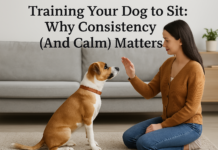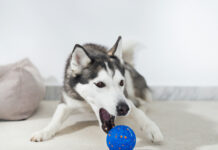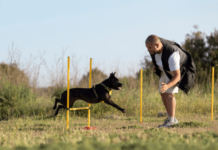Last Updated on October 14, 2024 by Dogs Vets
Living in a bustling city like London, having a well-trained dog is essential for ensuring your pet’s happiness and safety. Whether you’re raising a puppy or dealing with behavioral challenges in an older dog, finding the right dog trainer can transform both your life and your dog’s behavior.
This guide will help you navigate through the best dog training options near you in London, highlighting top services that can help with everything from basic obedience to advanced behavior correction.

Why Dog Training is Essential in London
Dog training isn’t just about teaching your dog basic commands like “sit” and “stay”—it’s about developing a lifelong bond built on trust and respect. In a city as busy as London, with its public parks, crowded streets, and various distractions, proper training helps ensure your dog can navigate the urban environment safely and happily.
Whether you’re walking through Hyde Park or visiting a café in Covent Garden, a well-trained dog means less stress for you and a better experience for your pup. That’s why dog training services in London have seen a surge in popularity, with trainers focusing on everything from obedience to managing complex behaviors such as separation anxiety or leash aggression.
Best Dog Training Services Near You in London
1. Dog Training London
If you prefer in-home training sessions, Dog Training London is an award-winning company that specializes in home visits throughout the city. Their highly trained, police-certified behaviorists and trainers offer a range of services, from puppy training to handling aggressive dogs. They employ positive reinforcement techniques to ensure long-lasting behavioral changes and have rave reviews for their customized approach.
2. Cwtches Dog Training
Based in South East London, Cwtches Dog Training provides a personal touch with force-free methods. Trainer Georgi, who has a background in behaviorism and psychology, offers both one-on-one and group sessions, focusing on building a strong, positive relationship between dog and owner. Their training programs include everything from puppy basics to handling specific behavioral issues.
3. Off Leash K9 Training London
For those looking for a structured approach, Off Leash K9 Training offers private lessons, advanced obedience courses, and a “Board & Train” program where dogs stay with trainers for immersive training. Off Leash K9 Training is popular among dog owners looking to address serious behavioral issues or advanced obedience.
4. Milne and Mutt
Jemma at Milne and Mutt focuses on reward-based, fun training methods. She offers one-on-one sessions, puppy classes, and behavior modification courses in South East London. Her approach is perfect for first-time dog owners and those dealing with specific issues like leash pulling or crate training.
What to Look for in a Dog Trainer

When searching for dog training near you, consider the following factors:
- Qualifications & Experience: Always check if the trainer has certifications from recognized institutions such as the Institute of Modern Dog Trainers (IMDT) or the Association of Professional Dog Trainers (APDT). Trainers with specialized behaviorist qualifications are ideal if your dog has more complex behavioral issues.
- Training Methods: Positive reinforcement is widely considered the most humane and effective method. Avoid trainers who use punishment-based methods as these can lead to fear or aggression in dogs.
- Specializations: Some trainers specialize in specific areas such as puppy training, separation anxiety, or aggression. Choose a trainer with experience in the areas where your dog needs help.
- Reviews & Testimonials: Check Google reviews and testimonials from other dog owners to get a feel for the trainer’s reputation. Many top London trainers have glowing feedback from their clients.
Benefits of Professional Dog Training
- Enhanced Obedience: A professional trainer will teach your dog the basic commands and much more. Your dog will learn how to walk on a leash without pulling, stay when told, and come when called, which is essential in a busy city like London.
- Improved Socialization: Trainers often offer group classes or controlled socialization sessions, helping your dog to interact safely with other dogs and people.
- Behavioral Solutions: Whether your dog is struggling with separation anxiety, barking, or aggression, a professional can help address the root of these issues, leading to a calmer, happier pet.
- Confidence in Public Spaces: From navigating crowded parks to hopping on the Tube, well-trained dogs are more confident and comfortable in public settings.
Conclusion
Dog training is a key part of ensuring that your dog is happy, healthy, and well-adjusted, especially in a vibrant city like London. By choosing a professional service near you, you’ll not only improve your dog’s behavior but also enhance your relationship with your pet. Whether you opt for a one-on-one session at home, group classes in the park, or an immersive “Board & Train” program, London offers a range of excellent options to fit your dog’s needs.
If you’re ready to find the perfect dog trainer in London, explore the options listed above, and get started on your journey toward a better-behaved, happier pup today!
For more options, check out Bark.com’s comprehensive listing of dog trainers in London here.

















